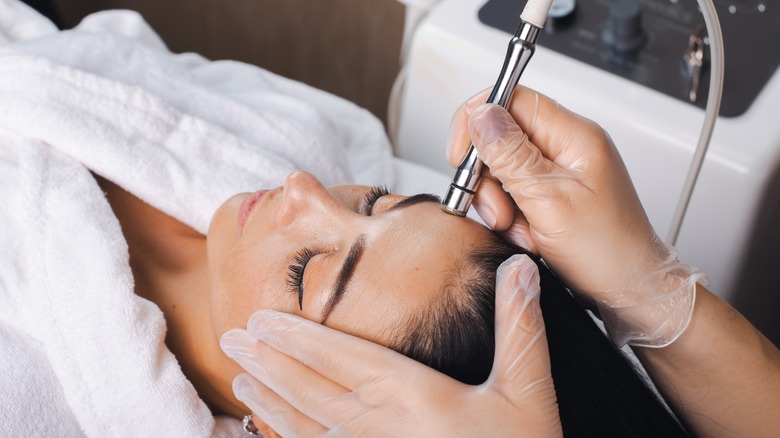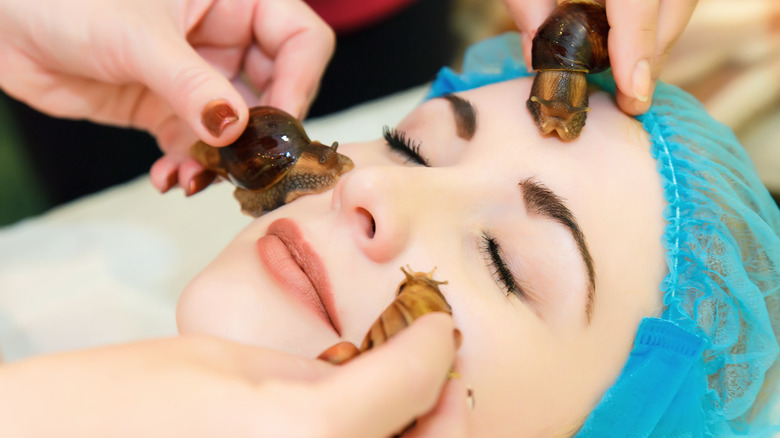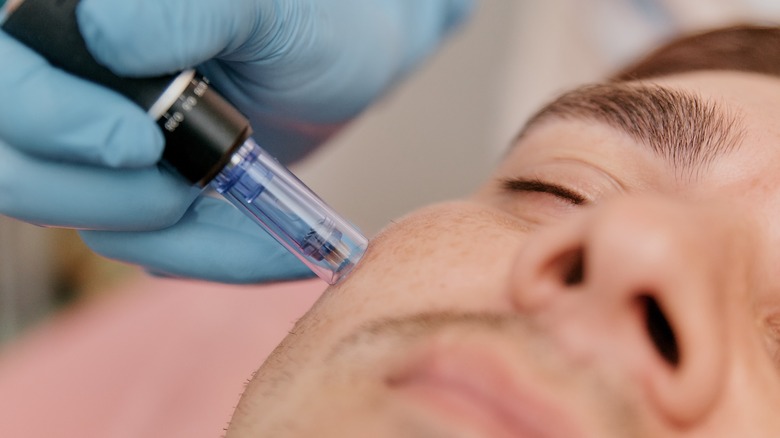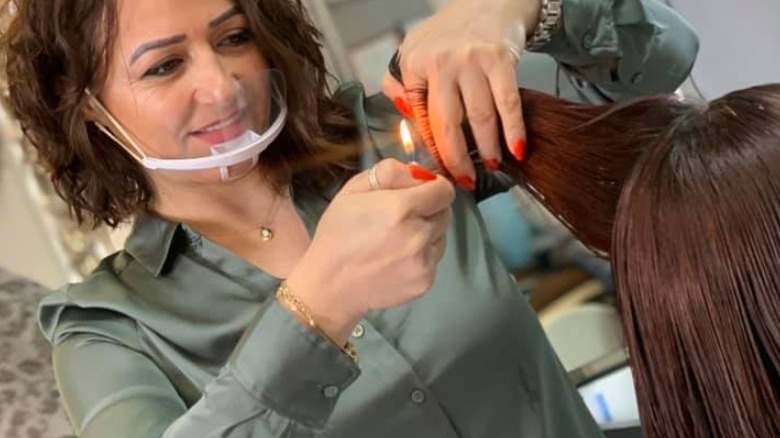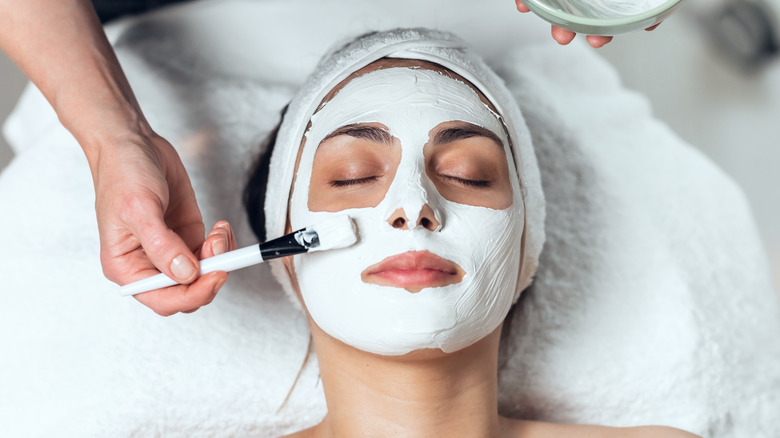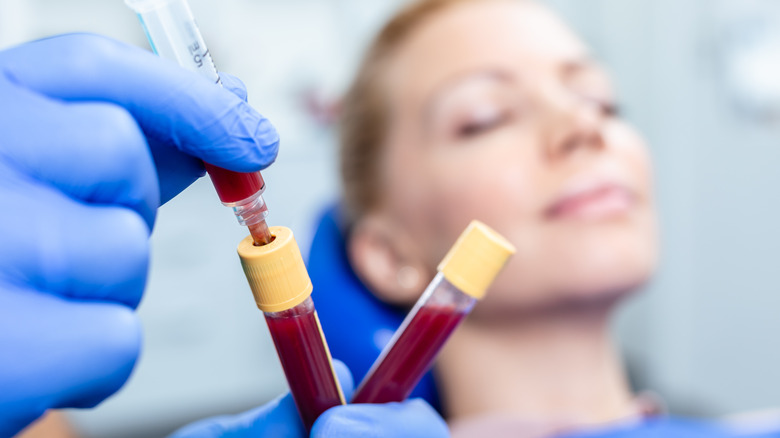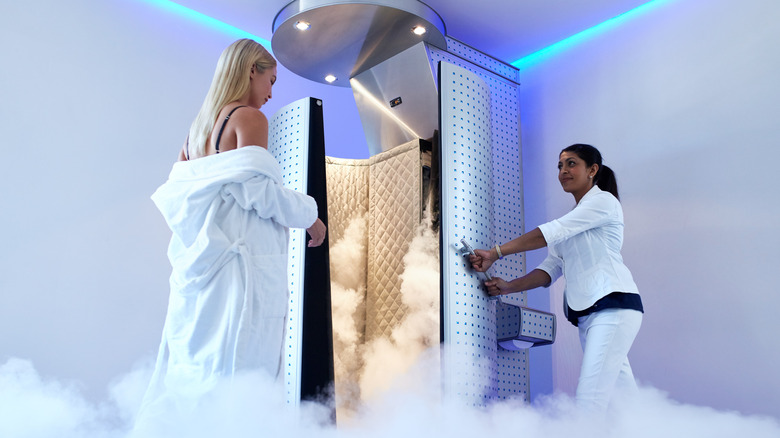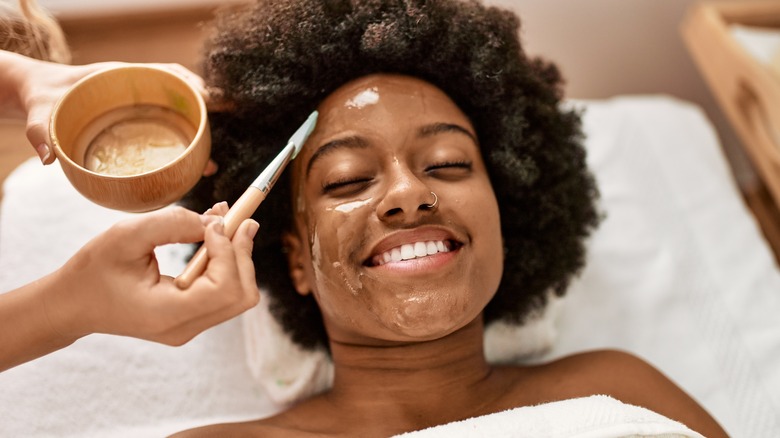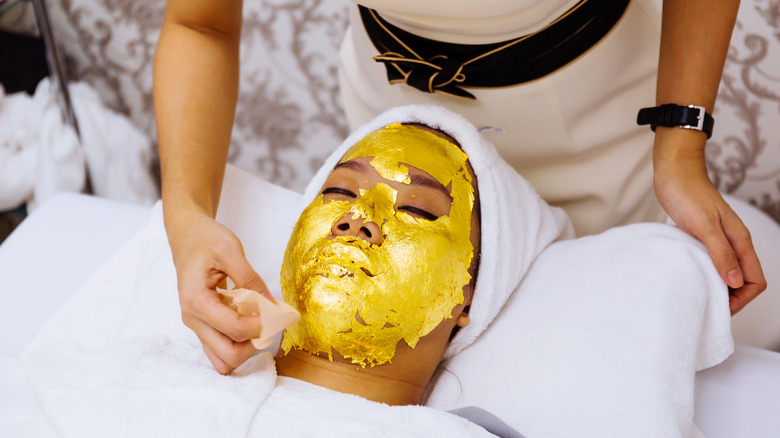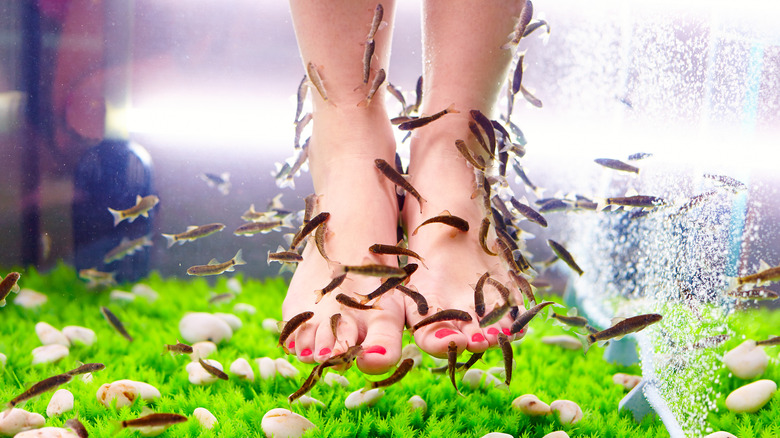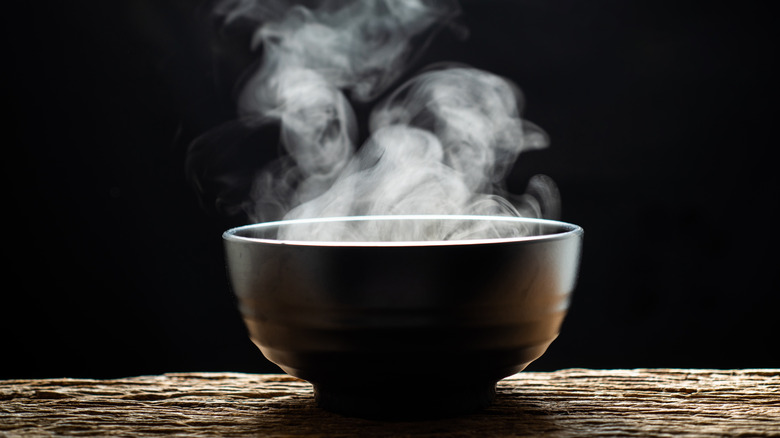The Strangest Beauty Treatments You Can Get Today
Whether it's a special treat to be indulged in, part of your regular beauty routine, or simply a way to target a particular concern, everyone appreciates a relaxing trip to the spa. And while hot stone massages and seaweed wraps are certainly classics (and for good reason), they can start to feel routine or even downright boring after a while.
Believe it or not, your favorite neighborhood spa is a great place to get a little adventurous and try something new, maybe a full-body mud mask or LED facial. But what if you're really the adventurous type and want to try something unique, unusual, or even downright strange while still reaping all the beauty benefits you would expect from your go-to aesthetician? This is your cue to step outside your comfort zone (or not, it's completely up to you!) and explore some of the strangest beauty treatments you can get today. So, let's break down our favorite options — you'll have many to choose from!
Snail mucin facial
Using snail slime, or mucin, in cosmetics is hardly news (especially outside of the United States), but it has been gaining steam recently in U.S. beauty trends. Per Healthline, snail mucin has been used in traditional folk medicine in various cultures for centuries but only began to gain broader recognition when the South Korean cosmetics industry discovered its many amazing skin benefits in the 1980s. Dozens of studies, like one published in the Journal of Drugs in Dermatology, have found snail mucin to reduce the appearance of wrinkles, fight acne, and moisturize the skin more effectively than traditional products.
While the faint of heart can certainly opt for a facial using products that simply contain snail mucin, the more adventurous beauty connoisseurs out there can choose a treatment involving live snails. Here's how it works: after a gentle cleansing, your aesthetician will place a few of the tiny gastropods on your face, allowing them to slither across your skin and leave behind a trail of their slimy skin-healthy goodness. If the idea of live snails crawling across your face grosses you out (absolutely no judgment here), or you're simply reluctant to jump right into a full snail mucin treatment, consider trying it out at home first. More and more, U.S. brands are starting to carry products containing snail mucin filtrates, making this seemingly-strange trend easy to test before committing to adding it to your regular beauty routine.
Placental stem cell facial
For those who might be unaware, the placenta (also known as afterbirth) is an organ that develops in the uterus of female mammals while pregnant, with the purpose of supplying oxygen and nutrients to the fetus. It's also an increasingly popular ingredient in many skincare products, thanks to its rich antioxidant and stem cell content, as well as its anti-inflammatory properties. Though the use of stem cells in healthcare is still relatively new, their use in the beauty industry is even more recent, meaning there are relatively few clinical studies exploring the efficacy of such procedures. However, the few studies that have been conducted (like the 2020 study published in the journal Nutrients) have found that the placenta and its extracts can lead to markedly improved skin quality, including reduced appearance of wrinkles and reduced hyperpigmentation.
Though the less adventurous can certainly opt for a treatment that only uses topical products containing placenta extracts, the more daring skincare proponents out there may prefer to go all the way, to getting a placental stem cell facial from a reputable medical spa. The procedure most often involves microneedling, using tiny sterile needles to open up channels in the skin that will be used to allow new, collagen-forming cells to develop. The placental extracts are then applied to the skin and allowed to work their magic, while your physician may inject extracts containing stem cells into any problem areas, such as a particularly deep or stubborn wrinkle. Placenta most often used in this kind of procedure is sourced from humans, though other skincare products might contain placenta sourced from sheep or even pigs.
Brazilian hair burning
No matter your hair type, chances are you've been acquainted with split ends at some point in your life, but did you know that there is a fiery alternative to simply going into your salon for a trim? Meet velaterapia, otherwise known as Brazilian hair burning or candle haircutting. As its name suggests, Brazilian hair burning originated in South America, where it has purportedly been practiced for centuries. Advocates insist that the procedure not only does away with split ends without compromising hair length but can also prevent dryness and future breakage all while leaving hair silky-soft and shiny. That being said, the procedure is lacking in scientific studies, and even a small mistake does run the risk of scorching more than just split ends. Though it goes without saying, we're going to say it: always consult a professional, and never try this at home.
So, how does Brazilian hair burning actually work? To start, your stylist will section your hair into small, tightly twisted strands. Then, one strand at a time, they will apply the flame of a burning candle along the strand's length for a few seconds at a time. This is usually followed up with a deep conditioning treatment, as the procedure is said to make hair more receptive to nutrients. In the end, the idea is that the heat from the flame will singe off split ends while at the same time sealing the open ends of the hairs. However, keep in mind that the procedure is a shock to the hair and should only be done every three to four months.
Nightingale facial
Also called the geisha facial or, perhaps more accurately, the bird poop facial, this beauty treatment has a long history originating in traditional Japanese skincare. Supposedly, it came along as a solution to the many damaging skin problems caused by past geishas' lead- and zinc-based cosmetics. The treatment, called uguisu no fun (literally "nightingale feces") in Japanese, utilizes the excrement of a particular species of nightingale called the Japanese bush warbler. Eastern and Western advocates alike insist that the treatment produces softer, smoother, and brighter skin thanks to the droppings' high urea and guanine content, both of which contain natural enzymes that simultaneously nourish and polish the skin.
In case you're wondering, yes, the procedure is completely safe from harmful bacteria that you might (rightfully) think are dwelling inside the nightingale droppings. Here's how it works: Once the birds' droppings have been collected, they are dried and sterilized using UV light before being ground into a fine white powder. That powder is mixed with water, and sometimes an exfoliating agent like rice bran, and applied to the skin for about 10 minutes before it's rinsed off. Users have described the smell of the mixture as an organic or musky aroma, though not entirely unpleasant.
Platelet-rich plasma therapy
Thanks in large part to celebrities like Kim Kardashian, platelet-rich plasma (PRP) therapy had a moment back in 2018 and has only continued to gain in popularity since then. Colloquially dubbed the vampire facial, the procedure uses platelets drawn from a client's own blood to address a number of common skin issues, most notably the effects of aging and acne scarring. Though costly (the price tag of a single treatment can run anywhere from $500 to $2,500), PRP therapy produces scientifically-proven results, with countless studies (such as one published in the International Journal of Molecular Sciences) detailing the benefits touted by some of our favorite celebrities.
The procedure starts with a blood draw; your physician will take about 2 tablespoons of blood from your arm and place the blood into a centrifuge. The centrifuge will separate the blood into layers, with the heaviest layers (containing the highest concentration of platelets) settling to the bottom. These platelet-rich layers will be extracted and injected back into the skin via microneedling. Once in the skin, the combination of the platelets and microneedling work together to stimulate the production of collagen, reducing or erasing the appearance of fine lines and wrinkles. A similar procedure, called the vampire facelift, can be performed by injecting platelet-rich plasma into the skin as you would a filler for similar results.
Cryotherapy
Cryotherapy–very basically the use of extreme cold in medical treatments–has been used for years in the medical industry to treat certain skin conditions and even some forms of cancer. However, it also has extensive cosmetic uses that experts are still exploring. Cryo facials are used to rid the skin of toxins, reduce puffiness, and tighten pores; cryotherapy has even been found to benefit aging skin by reducing the appearance of fine wrinkles and stimulating collagen production. A comprehensive 2022 study published in the journal Cosmetics identified even more uses for both targeted and whole-body cryotherapy, including benefits to the vascular, hormonal, and immunological systems. In other words, this is some seriously beneficial science.
In terms of targeted treatments, like a cryo facial, a trained professional will use a small device attached to a hose to pump liquid nitrogen over your skin, being careful to move the device quickly and hold it far enough away from your skin so as not to cause frostbite (the liquid nitrogen will be cooled to around -250 degrees Fahrenheit, after all). Full body treatments involve much larger cryo-chambers that will expose your entire body to such frigid temperatures for anywhere from two to four minutes.
Baby foreskin facial
What some would consider one of the more bizarre beauty treatments out there, the proper name for the procedure dubbed the baby foreskin facial is actually the epidermal growth factor (EGF) facial. And despite its strange central ingredient, the treatment is gaining steam in the US thanks to endorsements by such celebrities as Cate Blanchett, Sandra Bullock, and Kate Beckinsale. The cells, specifically fibroblasts, derived from the recently-circumcised foreskins of newborn babies are thought to secrete large amounts of human growth factor proteins, which can stimulate the skin's production of collagen and elastin and promote cell regeneration. The result, according to advocates of the procedure, is younger-looking skin and an overall improved skin tone.
Fortunately for everyone, the treatment does not actually involve placing foreskin on the face. Instead, the foreskin's beneficial fibroblasts are distilled into a serum, which is then incorporated into what is an otherwise "normal" facial treatment. That is unless you opt to incorporate microneedling into the procedure, which advocates highly recommend in order to reap the full benefits of the EGF serum. Microneedling creates channels in the skin that will allow the serum and its collagen-stimulating cells to penetrate deeper into the skin, where it can best do its work.
Pure gold facial
Gold has a lengthy history of both medicinal and cosmetic use, going back thousands of years to ancient Indian, Chinese, and Arabic folk medicine. And though it's no longer the first line of treatment, there were times in the recent past when medications containing gold products were prescribed to treat such conditions as rheumatoid arthritis and cutaneous lupus. While modern studies on the true dermatological benefits of gold are sadly lacking, advocates of gold facials swear that the procedure can reduce inflammation and redness, improve circulation, and fight visible signs of aging.
The gold used in facials and other skincare products is usually 24-karat colloidal gold, consisting of nanoparticles of the precious metal suspended in a liquid, which allows the particles to penetrate deeper into the skin. However, some spas feature gold facials involving gold leaf that an aesthetician will massage into your face. Otherwise, the treatment generally follows the traditional facial format of cleansers, exfoliants, extractions, and masks, making it one of the less-invasive procedures on this list. Even so, the cost of the treatment can be quite high, with average prices ranging anywhere from $100 to $300 per facial, with some high-end spas charging up to $1,000.
Fish pedicures
A slightly more controversial treatment, it's likely you've heard something about this one before; it involves submerging the feet into a tank of water containing a small school of fish (a specific species of fish called garra rufa) that will then go to work eating away any dead skin cells they can find. Advocates of the procedure insist that the fish's work will soften calluses, get rid of any rough or dry patches, and ultimately result in baby-soft skin. However, many medical professionals are skeptical about the procedure, and rightly so, as it does carry a risk of bacterial infection. It is also difficult to effectively sanitize the fish's tank, and there have been — albeit rare — cases of the hungry fish causing long-term damage to clients' nails.
Doctors' skepticism aside, many people have boycotted the procedure due to its inhumane treatment of the fish themselves. Garra rufa are native to the Middle East and typically prefer to feed on plankton and other plant sources, only nibbling on human flesh when they have nothing else. As a result, spas that offer fish pedicures are often required to starve the little swimmers so that they will be more enticed to perform their job. In the end, there has to be an easier (and kinder) way to achieve those sought-after baby-soft feet.
Vaginal steaming
A practice that's been used in Central and South American cultures for centuries to address a myriad of concerns, Gwyneth Paltrow recently drew renewed Western attention to the practice on her blog. (In case you're wondering, yes, she is a proponent.) Some of the purported benefits of applying steam to the vagina include relief from irregular periods and the after-effects of childbirth. There are even claims that it can help with yeast infections and infertility and reduce overall stress. However, gynecologists are wary of the practice for a number of reasons, starting with the near-complete lack of scientific studies.
In practice, the treatment involves sitting or squatting over a pot of hot, steaming water that is usually infused with herbs like mugwort or chamomile. Sometimes a blanket is draped or wrapped around the lower body to prevent the steam from escaping. Though these herbs can, in certain contexts, prove beneficial to a person's health, gynecologists warn that exposing your nether regions to the steamed herbs could alter your vagina's pH levels, putting you at risk for yeast infections or even bacterial vaginosis. A 2022 article published in the Cleveland Clinic's Health Essentials blog takes a deeper dive into the practice, ultimately concluding that the dangers could very likely outweigh the actual benefits.
Venom facials
In case Botox is a little too mainstream for you, you can always try an anti-aging treatment involving snake or bee venom. The procedure isn't as bizarre as you may think, at least not when you consider the reasoning behind it. Aesthetician to the stars Sonya Dakar pioneered the use of snake venom in her products–specifically, the venom of the temple viper–on the basis that the substance can aid in relaxing facial muscles when applied topically, as well as reduce the appearance of wrinkles and produce younger-looking skin. Both Gwyneth Paltrow and Katie Holmes are reportedly fans of the treatment.
There are no fangs or needles involved in venom facials; instead, they typically follow the traditional facial format, incorporating the venom into the products used by your aesthetician. However, apitherapy, or the use of products derived from bees for medicinal and cosmetic use, can be another story altogether. While many products and spas are already making use of bee venom, a stinging new therapy has been creating more and more of a buzz in the U.S. This might even push you to want to learn the truth about bee sting therapy.
